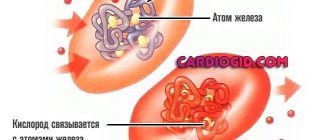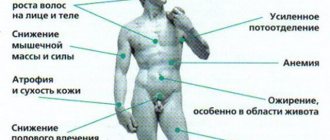Hormones play a special role in human existence. Overestimated or underestimated indicators indicate a violation of the functions of organs and secretions of the body. For the reproductive system of women during the fertile period, anti-Mullerian hormone has priority. Its level is directly related to the ability to conceive, bear and give birth to a child. Hormonal imbalance negatively affects the general condition of a woman and can cause dysfunction of the reproductive system. Therefore, it is very important to conduct clinical studies in a timely manner. To figure out when and on what day of the cycle it is better to take anti-Mullerian hormone, you need to understand the nature of its origin.
What is anti-Mullerian hormone?
Anti-Mullerian hormone or anti-Mullerian hormone (AMH for short) indicates the number of eggs a woman of reproductive age has, as well as the activity of her ovaries, so it is considered an indicator of female fertility. This concept is widely used in reproductive medicine. Most often you will encounter it in the context of pregnancy planning or infertility treatment.
The hormone got its name from the German anatomist Johannes Peter Müller. He discovered that this hormone begins to play its role in a woman's body with the onset of puberty. At this moment, the ovaries begin to produce AMH, or rather granulosa cells, which surround the follicles growing in each cycle. At the same time, we are not only talking about the dominant follicle in a woman’s natural cycle, which has the potential for the birth of a new life. This hormone is produced for all eggs that “start” at the beginning of the cycle (the so-called antral follicles).
Accordingly, there is a theory that the higher the AMH content in a woman’s blood, the greater the “reserve” of eggs in her ovaries and the higher her reproductive ability. If the level of this hormone is significantly reduced, then this may indicate that the woman’s reproductive function is already in decline, that is, the number of eggs in her ovaries has decreased significantly.
When is it appointed?
A blood test for AMH is prescribed in the following cases:
- To determine the presence/absence of failures during puberty.
- If there are problems with sex determination (false hermaphroditism).
- When it is necessary to assess a man’s sexual function, regardless of age.
- For determination and further monitoring in the detection of cancer processes affecting the ovaries.
- To determine the reasons for unsuccessful artificial insemination.
In general, a blood test for AMH allows you to find out the causes of infertility, IVF failure and other problems. In addition, an analysis of Athymüllerian hormone allows people with tumors, sexual dysfunctions, infertility, and women who want to make sure their ovaries are working to get answers.
When is a hormone test needed?
In addition to an indirect indication of the number of eggs ( ovarian follicular reserve) in a woman, the result of an analysis for this hormone can be used for other indications:
- Predictions of success for the IVF procedure
- Evaluation and dosage of hormonal stimulation in the treatment of infertility
- Reducing the risk of hyperstimulation during infertility treatment
- Diagnosis of premature ovarian failure or early menopause (up to 40 years)
- Assessment of ovarian damage resulting from chemotherapy or radiation therapy. In this case, AMH decreases due to the destruction of active oocyte cells.
- Diagnosis of polycystic ovary syndrome (hormone levels are significantly increased)
Knowing your ovarian reserve is especially interesting for women over 30 who want to get pregnant. If you encounter difficulties conceiving, then it is possible that your ovaries are gradually depleted, i.e., with each cycle the number of follicles that have a chance to become dominant decreases.
What do deviations from the norm indicate in women?
Any deviations from the norm indicate a malfunction of the woman’s reproductive organs.
Results above normal are possible in the following cases:
- Lack of ovulation within several menstrual cycles.
- Polycystic ovary syndrome.
- Granulosa tumors of the ovaries.
- Congenital pathology of the ovaries.
- Infertility.
- Lag behind the norms of sexual development.
- The result of antiandrogen therapy.
Results below normal indicate the presence of such deviations:
- Premature sexual development in a girl.
- The onset of menopause in women.
- Low FSH levels.
- Therapy with ovariotoxic drugs is carried out after surgery.
The indicator may also be low in the presence of obesity, in the premenopausal period and after severe poisoning.
How is the AMH test performed?
The AMH test is a simple blood test. It can be carried out by a gynecologist or in any independent laboratory. Previously, it was believed that the concentration of the AMH hormone does not depend on contraception and does not change during the cycle. Therefore, determining its level is possible on any day of the cycle. But according to recent studies, its level may fluctuate, especially in young women. It can change from cycle to cycle, and also decrease before ovulation.
Normal hormone values
In women of reproductive age from 18 to 30 years, one milliliter of blood contains from 1 to 5 nanograms of anti-Mullerian hormone, sometimes it can be slightly higher. Starting from the age of 30, the concentration of the hormone decreases. If its value becomes less than 1, then this indicates limited ovarian function and a weaker response during their stimulation.
Below is a table of values and their norms according to the results of the Invitro laboratory:
- From 1 to 5 ng/ml - normal fertility
- From 0.8 to 1 ng/ml - reduced fertility
- Less than 0.16 ng/ml - menopause
- From 5 to 15 ng/ml - polycystic ovary syndrome is possible
However, experts recommend not relying on just one AMH value, but confirming the test result with an ultrasound examination of the ovaries. The doctor should count the number of antral follicles at the beginning of the cycle, and also conduct an additional blood test for FSH, LH and estradiol. Increased FSH and LH and decreased estradiol, as well as a small number of antral follicles and decreased levels of the AMH hormone, together indicate declining ovarian function.
Preparation and analysis procedure
In order for the results to be as reliable as possible, before taking the analysis you must adhere to the following rules:
- Do not exercise three days before going to the laboratory.
- Eliminate fatty and junk foods from your diet.
- Give up alcohol one day before.
- Minimize stressful events.
- Stop taking steroid medications 2 days before.
Doctors recommend coming to the clinic in the morning, since the test is taken on an empty stomach. If absolutely necessary, you can drink any non-carbonated water. On the day of the test, you should stop smoking. If shortly before the hormonal test the patient had a cold or flu, it is recommended to reschedule the test. Children under 5 years old must drink warm water before donating blood.
Blood is drawn from a vein. Using a special serum, the quantitative content of Anti-Mullerian hormone and the volume of the ovary are determined, and the eggs that can be fertilized during the current cycle are counted. The results of the study become known on day 2.
Low AMH levels and pregnancy
If you have low levels of the hormone, and family planning has not yet been completed or has not even begun, then you need to hurry. First, the good news: the number of eggs, that is, their supply, does not affect the quality of the eggs. A large number of eggs does not always indicate a higher probability of conception, since these eggs may, for example, have chromosomal abnormalities. To conceive, one healthy egg is enough, and not 10 of questionable quality.
Even if anti-Mullerian hormone is no longer in a woman's blood, pregnancy through reproductive technology is still possible (though not guaranteed). The very presence of menstruation indicates that a woman still has a supply of eggs in her body. This means that small chances still exist. Only after the cessation of menstruation can we say that reproductive age has completely ended.
Factors that reduce hormone levels:
- Long-term use of oral contraceptives can reduce its level by 30%
- In smoking women, the level of this hormone is significantly reduced compared to non-smoking women. At the same time, there is no dependence on the number of cigarettes consumed. If you have low AMH and are planning a child, then when you give up nicotine, the level of this hormone may increase.
- Some studies suggest that taking DHEA, a steroid hormone, may improve the chances of conceiving in women with low AMH. But there is no clear confirmation of this theory yet.
- Also, taking vitamin D can increase AMH if a vitamin D deficiency was previously detected.
It is important to know that increasing this value by any means should not be an end in itself in the process of pregnancy planning. Do not forget that a high level of this hormone does not guarantee an early pregnancy. And a low level is not an absolute obstacle to its occurrence.
A low AMH value may indicate that your egg supply is running low, but this value alone is not enough to predict your chances of pregnancy. Combined factors such as tubal patency, endometrial health, or sperm quality should always be assessed.
Let's sum it up
To summarize, it should be emphasized:
- despite the absence of significant fluctuations in the level of the parameter under consideration during the month. The optimal period for donating blood is from the fifth to the seventh or from the 3rd to the 5th day of the cycle;
- general rules for preparing for the study consist of adjusting the diet, giving up alcohol and smoking, and taking medications in consultation with the doctor;
- isolated data on the level of anti-Mullerian hormone is not enough to make a final decision about a woman’s health and her ovarian reserve. If there is a suspicion of depletion of the egg supply, additional tests are prescribed for the level of follicle-stimulating and luteinizing hormone. In the case of extended diagnosis of ovarian cancer, the value of CA125 and inhibin B is additionally determined.
Yulia Martynovich (Peshkova)
Certified specialist, in 2014 she graduated with honors from the Orenburg State University with a degree in microbiologist. Graduate of the graduate school of the Federal State Budgetary Educational Institution of Higher Education Orenburg State Agrarian University.
In 2020 At the Institute of Cellular and Intracellular Symbiosis of the Ural Branch of the Russian Academy of Sciences, she completed advanced training in the additional professional program “Bacteriology”.
High levels of the hormone AMH
If the AMH level is significantly elevated (above 5.0 ng/ml), this does not always indicate excellent reproductive function and increased fertility. Very often, this level indicates a disease such as polycystic ovary syndrome (PCOS). This syndrome is manifested by the growth of a large number of low-quality follicles during one cycle. In connection with this diagnosis, a woman may experience a cycle disorder (very long cycles or its complete absence). This syndrome often occurs in overweight women.
New research at Koshan Medical University has found that taking the drug metmorphine can significantly reduce the concentration of the hormone in the blood of women with PCOS and thus improve their chances of conceiving. In this study, AMH levels were measured before and 8 weeks after initiation of metformin (1500 mg per day). As a result, AMH levels were reduced, and the greater the woman's weight (BMI), the greater the effect of this therapy.
Do I need to choose a day to take the test?
The specialist definitely decides on which day of the cycle to take the AMH test. In most cases, the doctor recommends the third day from the beginning of the menstrual cycle, since then the level of other female hormones can be determined at the same time. If the menstrual cycle is not characterized by regularity, then the examination can be carried out at other times. Reproductive doctors are confident that there is absolutely no fundamental difference in choosing the day, and it is quite acceptable to set a date for the test on any day. In their opinion, the results of the study will not differ significantly.
Anti-Mullerian hormone in IVF
If you have been diagnosed with infertility (pregnancy does not occur within a year of regular sexual activity at least 2 times a week without the use of contraceptives and methods), then you may have to undergo an IVF procedure.
The level of the AMH hormone helps make an initial prediction about the required dosage for ovarian stimulation. If AMH is low (below 1.0 ng/ml), then the dose for stimulation may be higher than usual, but if it is elevated or at the higher limit, then the dose will be reduced to avoid the risk of hyperstimulation (one of the serious complications that occurs with excessive response of the ovaries to stimulation of superovulation). Unfortunately, there are no unambiguous algorithms for determining the optimal dosage, since each woman is individual. It is not possible to completely avoid the risk of hyperstimulation or low ovarian response even with a known AMH value.
Deviations in results in men
Let's look at what low AMH levels mean in men:
- Congenital pathology of testicular development in boys.
- Testicular fibrosis.
- Delayed sexual development.
- The production of male sex hormones is disrupted.
- Impaired spermatogenesis.
- Testicular dysgenesis.
Also, AMH levels may decrease with age due to obesity and early puberty.
In what cases can the indicator be increased:
- There is a testicular tumor.
- Violation of testosterone production.
- Early puberty.
- Cryptorchidism.
- Congenital pathologies of the testicular structure.
- Development of the genital organs according to the female type.
With the results, you need to consult a doctor to find the cause and begin treatment.
Decreased anti-Mullerian hormone. Menopause?
Many women planning a pregnancy and having low AMH are afraid that they will soon enter menopause. This condition occurs sooner or later in every woman, but there is no need to fear it with low AMH, as the latest research has shown.
The total number of eggs in a woman’s body is laid down from her birth. After puberty, their number begins to decrease, but this happens gradually and at different rates in different women. The function of the ovaries fades with age, and their work completely ends at the onset of menopause. The onset of menopause varies from woman to woman and can vary greatly. For most women, symptoms first appear around age 50. However, some women experience premature ovarian failure before age 40, while other women continue menstruating until age 60.
Previously, it was believed that if AMH is significantly reduced, this indicates the imminent onset of menopause. This theory has already been refuted by new research, which does not provide an exact answer to the relationship between AMH levels and the likelihood of conception. In three out of five women, anti-Mullerian hormone levels drop to zero long before menopause. At the age of 45 to 50 years, in most women this hormone is no longer detectable in the blood. But even in this case, it is impossible to make accurate predictions about the imminent onset of menopause. For many women, menopause occurs years after AMH is no longer detectable in the blood.
The study on which the above is based was conducted by Dr. Freeman and Sammel at the University of Pennsylvania in 2012. They followed 401 women over 14 years. All of these women had regular menstruation between the ages of 35 and 48 years. In 75% of these women, the AMH value dropped to 0 (<0.2 ng/ml) within 14 years, but only half of them reached menopause within these 14 years. The result of the study: from the moment AMH dropped to zero until the onset of menopause (i.e., the onset of the last menstruation) took about 6 years . Moreover, the younger the woman was, the longer this period was. In women aged 35 to 39 years, menopause occurred 10 years after AMH decreased to zero. If its value was from 0.7 to 1.5, then menopause was still about 13 years .
But even if new research results give a more positive forecast for the likelihood of conceiving with low or absent AMH, doctors advise not to delay planning a pregnancy for a long time.
When to take AMG, on what day of the cycle tips and recommendations
Hormones play a big role in our body. They affect the activities of all systems. They play an important role in conceiving and bearing a child. Thus, doctors advise married couples who cannot become parents to get tested for hormone levels. Often it is these deviations that play a decisive role. There are many such tests, but I would like to focus on the AMH analysis. When to take the hormone, on what day of the cycle, what significance does it have for the female and male bodies. More on this later in the article, as well as some tips on what recommendations you need to follow to prepare for the test.
Anti-Mullerian hormone plays different roles in the male and female body. But in both cases this concerns reproductive function. Before answering the question about which day of the cycle you should take AMH, let’s consider its significance for the female body:
- Produced from birth until menopause.
- There is no way to determine it before the onset of puberty.
- In the middle of the reproductive period, the number increases.
- During menopause it drops to almost zero.
- Shows how the ovaries work.
- Used to diagnose cancer of the female reproductive glands during menopause.
- It is an indicator of how many eggs are suitable for fertilization.
- The lower the AMH level, the less likely you are to become pregnant.
- AMH levels can be used to determine when menopause will occur.
- The AMH level is determined in order to assess the ovarian reserve for the IVF procedure.
Let's consider what role AMH plays in the male body.
In men, the anti-Mullerian hormone is also responsible for the reproductive functions of the body. Namely:
- It begins to form in the body during the embryonic period.
- Controls the formation of the organs of the reproductive system.
- Produced before puberty.
- During puberty, maturity decreases.
- Affects sexual functions.
- A high level may indicate a tumor process or an abnormality in the structure of the genital organs.
It was discussed above what role AMH plays for men and women. When to take it, on what day of the cycle, then after we determine in what cases this analysis is necessary:
- Pregnancy does not occur for unknown reasons.
- Drugs are used that affect the functioning of the ovaries.
- IVF does not give the desired result.
- Early onset of menopause.
- Examination of the ovaries to detect malignant processes.
- Conducting androgen therapy.
- Determination of the presence of testicular tissue.
- Doubts about the child's gender.
In these cases, it is necessary to determine the AMH level.
When to take it, on what day of the cycle and what analysis requires preparation, more on that later.










